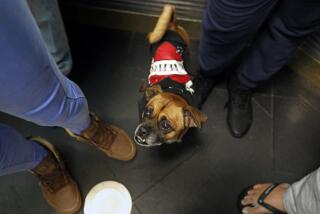Biscuit was my first rescue dog. I will never forget the way he stretched before a walk, his shake after waking from a nap, the way he fell over effortlessly for a belly rub, the way he raised his paw and pressed it against my leg when he wanted more treats, and most of all, his smile.
Before he came into my life, he’d been found abandoned wandering rural back roads in North Carolina, terrified, drastically underweight, his fur coat matted and nonexistent in patches, and his rear legs permanently deformed probably because he’d spent countless hours in a small wire cage. Biscuit was taken to a rescue in Maryland where he received veterinary care and treatment. When my husband and I adopted him, he began emerging from his shell. Over time, a dog that once cowered behind chairs and tables and avoided humans became a true companion, a best friend.
With Biscuit as my inspiration, I began a decadelong project documenting the fate of nearly 60 other abandoned dogs. I photographed them prior to their adoption and learned their stories, then did it all again a year or so later.
Sixty dogs are just a sliver of the overpopulation crisis. More than 3 million dogs entered shelters and rescue organizations in 2023; 2.2 million found homes, but 1 million did not. Many of those animals were euthanized. There are so many unwanted dogs in America that the shelters are overwhelmed. In May, some of the Los Angeles Animal Services’ shelters were operating at more than double their capacity — around 211% full.
Biscuit died of a rare cancer in 2013. He rekindled my love of photography and changed my life in extraordinary ways. There are countless reasons why dogs are abandoned — some cruel and trivial, some sadly unavoidable. Shelters and rescues do heroic, necessary rehabilitation, providing veterinary care, vaccines, spay and neutering, foster families, adoption services — but they are way stations. Happy endings require humans to write them.

Jacks/Taco – English bulldog
Jacks was about 5 years old, underweight but sweet and loving when he was surrendered to a shelter and moved to a rescue organization in 2014. Fostered first, he was adopted by a family who had been searching for an English bulldog rescue and spotted him online. They renamed him Taco. Nothing is mundane to Taco, I was told, a year later. He gets excited about a car ride or a frozen yogurt; he’s a constant reminder “to enjoy the little things in life.”

Toby – hound/shepherd mix
Toby was a senior dog — 8 years old — when his owner surrendered him to a shelter in 2013. It took three tries before an adoption worked out. All told, Toby spent 1,216 days in the rescue, a record for the dogs I followed on this project, most likely because, as the vets at the rescue put it, he had “separation anxiety.” In the end, Toby’s adopters didn’t mind the extra attention he needed: “We just felt pulled to him.”

Treasure/Chessie – Chihuahua/Chi mix
Treasure, renamed Chessie when she was adopted, was rescued in 2014 from a puppy mill where she was probably a breed dog. Estimated to be 4 years old, Chessie was “very untrusting,” according to the veterinary team at the shelter that took her in, “especially of men.” Nonetheless, a couple made her their first-ever rescue dog after seeing her on Facebook. A year later Chessie was one of a “gang” of Chihuahuas, “a joy” — but still skittish around men.

Dagwood – golden retriever/Labrador mix
Found locked in an empty house in Indiana in 2012, Dagwood landed at a rescue in Maryland with “basic manners” but anxiety and fear as well. After a volunteer took him on a field trip to a nursing home, the manager agreed to a trial-run adoption, and now Dagwood is a professional support dog adopted, unusually, by a business. He “lights up the residents’ day just by being himself,” I was told. “Everyone loves Dagwood.”

Dreifuss/Dreyfuss – orange Labrador mix
Dreifuss’ name got a new spelling when he was adopted in 2014. Transferred to a Maryland rescue from Tennessee, his left front leg had been amputated and he was diagnosed with a condition that causes his limbs to deviate outward. But Dreyfuss compensates. “Special needs” animals aren’t the first to be claimed, but as his adopter says, “Dreyfuss isn’t a dog to feel sorry for.” The missing leg? “He doesn’t seem to miss it.”
Katherine Carver is an attorney and photographer residing in the Washington, D.C., area. The photographs and text are adapted from her forthcoming book “Abandoned: Chronicling the Journeys of Once-Forsaken Dogs.
More to Read
A cure for the common opinion
Get thought-provoking perspectives with our weekly newsletter.
You may occasionally receive promotional content from the Los Angeles Times.










